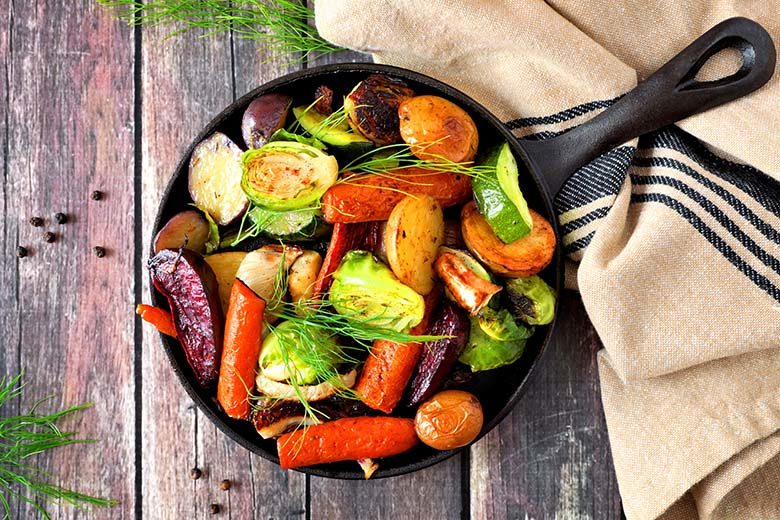
While the average home cook may not notice a difference between a skillet or sauté pan, there are some key differences. Skillets, often called fry pans or frying pans, have slanted sides while a sauté pan has straight sides. Skillets are made with various materials in several sizes, each with its own capabilities and advantages.
Cast Iron
Cast-iron skillets can withstand and retain high amounts of heat, making them ideal for searing meats or creating a coveted crispy exterior on almost any food. Easily transfer a cast-iron skillet from stovetop to oven or use it on the grill or over an open flame such as a campfire. Downsides of cast iron are that the material takes time to heat up; is prone to hot spots, which can lead to uneven cooking; can discolor and alter flavor of acidic foods; and can rust. Preheating cast-iron skillets can help speed up the cooking process.
Cast-iron skillets come in sizes as small as 3½ inches in diameter to as large as 15 inches. Most cast-iron skillets are pre-seasoned, meaning they have undergone the process of baking oil onto the cast iron and carbon steel, giving them a classic black color and creating a natural nonstick surface.
Wash cast-iron skillets by hand under hot running water using a small amount of soap and a nonabrasive brush or scrub pad as needed. To remove stubborn stuck-on food, simmer a small amount of water in the pan for a minute before using a pan scraper. Dry thoroughly with a lint-free cloth or paper towel, then set over medium-low heat to ensure there is no remaining moisture. Add a light layer of cooking oil and wipe with a paper towel to maintain seasoning. Let the skillet cool completely before storing.
Carbon Steel
Made with a mix of carbon and steel, this skillet has qualities similar to cast iron but is slightly lighter in weight. Because of this, carbon-steel skillets can distribute and maintain heat faster, helping to speed up the cooking process.
Durable and versatile, carbon-steel skillets can be used to cook just about anything. Use caution when cooking with wine or acidic foods such as tomatoes, which can damage the pan. Clean carbon-steel skillets according to the manufacturer’s instructions with hot water only (no soap) and dry immediately. Like cast iron, most carbon-steel skillets come pre-seasoned but should be re-seasoned after each use. To do so, heat a small amount of cooking oil in the pan, allow it to cool, then wipe with a paper towel.
Stainless Steel
Like cast iron and carbon steel, the stainless-steel skillet is durable, versatile and can be used from stovetop to oven. Although it is lighter in weight, it is a poor heat conductor, does not distribute heat evenly and is prone to hot spots that can cause food to burn. Unlike cast iron or carbon steel, stainless-steel skillets are not coated or seasoned, which can result in food sticking to the pan if not properly oiled or heated. Most stainless-steel skillets are dishwasher-safe and can be safely washed with soap and hot water.
Copper
Copper is dense and long-lasting but also heavy and expensive. Copper skillets conduct heat in almost the opposite way of cast iron. Cast iron takes a longer time to heat up, and once it is hot, it can hold heat for a long period of time; copper is quick to heat up and heats more evenly but loses heat quickly. Since copper is prone to reacting with or leaching into acidic foods, potentially making them toxic, it often is lined with other materials such as stainless steel to increase its durability and keep it from reacting with foods.
Clean the interior lining of a copper skillet with soap and hot water. The pan’s exterior is prone to oxidation, which can cause it to turn a greenish color if left untreated. While some prefer this rustic look, the skillet can be carefully washed with a nonabrasive sponge, dried immediately and polished with a copper cleaner. To avoid damaging the surface, do not put copper skillets in a dishwasher or clean with steel wool.
Nonstick
Many skillets are made of stainless steel or aluminum with a nonstick coating that also makes cleanup quicker and easier. This differs from other skillets, since seasoning at home is not required. Use a nonstick skillet to cook foods from pancakes and eggs to salmon and sautéed vegetables with little or no oil. Many nonstick skillets also can be used in the oven but may have a limited range of temperatures they can withstand.
To help maintain the nonstick surface, avoid using metal utensils and use wood, plastic or silicone instead. While nonstick skillets may be dishwasher-safe, the harsh cleaning and high temperatures can degrade their nonstick surface. Wash by hand with warm soapy water and a nylon brush or soft sponge and dry completely before storing.
References
All About Seasoning. Lodge Cast Iron website. Published September 2019. Accessed March 20, 2020.
Becker E, Becker J, Becker MR, et al. The Joy of Cooking. 2019 ed. New York, NY: Simon & Schuster, Inc. 2019:1066.
Caring for Copper: Williams Sonoma. Williams Sonoma website. Accessed March 20, 2020.
Cast Iron Product Guide. Lodge Cast Iron website. Accessed March 20, 2020.
Cook it in Cast Iron, Caring for Cast Iron: Cooking and Cleaning. America’s Test Kitchen website. Accessed July 17, 2020.
Cook it in Cast Iron, Chapter 4: Busting Cast Iron Myths. America’s Test Kitchen website. Accessed July 17, 2020.
Farrell MHJ. Best Nonstick Frying Pans From Consumer Reports’ Tests. Consumer Reports website. Published January 8, 2020. Accessed March 20, 2020.
How to Use & Care for Nonstick Cookware and Bakeware. American Kitchen Cookware website. Accessed July 17, 2020.
Lau N. The Best Carbon Steel Pans Review: Our Top 4 Picks for 2020. Stone Frying Pans website. Accessed March 20, 2020.
Vigor 11″ Stainless Steel Fry Pan with Aluminum-Clad Bottom. WebstaurantStore website. Accessed March 20, 2020.








